Within freeopen source software (and free content moregenerally), there are two major categories of copyright licenses:
- If content is published with a permissive license(eg. CC0,MIT), anyone can takeit and use it and redistribute it for any purpose with no restrictions,perhaps with minimal rules requiring attribution.
- If content is published with a copyleft license(eg. CC-BY-SA,GPL), anyonecan take it and use it and redistribute copies with no restrictions, butif you create and distribute a derivative work by modifying itor combining it with other work, the new work must also be releasedunder the same license. Additionally, GPL requires any derivative workto openly publish its source code, in addition to afew other requirements.
In summary: permissive licenses freely share with everyone,copyleft licenses freely share only with those who are also willing tofreely share.
I have been a fan of, and developer of, free open source software andfree content ever since I've been old enough to understand what thesethings are and build things that I thought other people might finduseful. Historically, I was a fan of the permissive approach (eg. myblog is under the WTFPL). Morerecently, I am warming up to the copyleft approach. This post explainsmy reasons why.
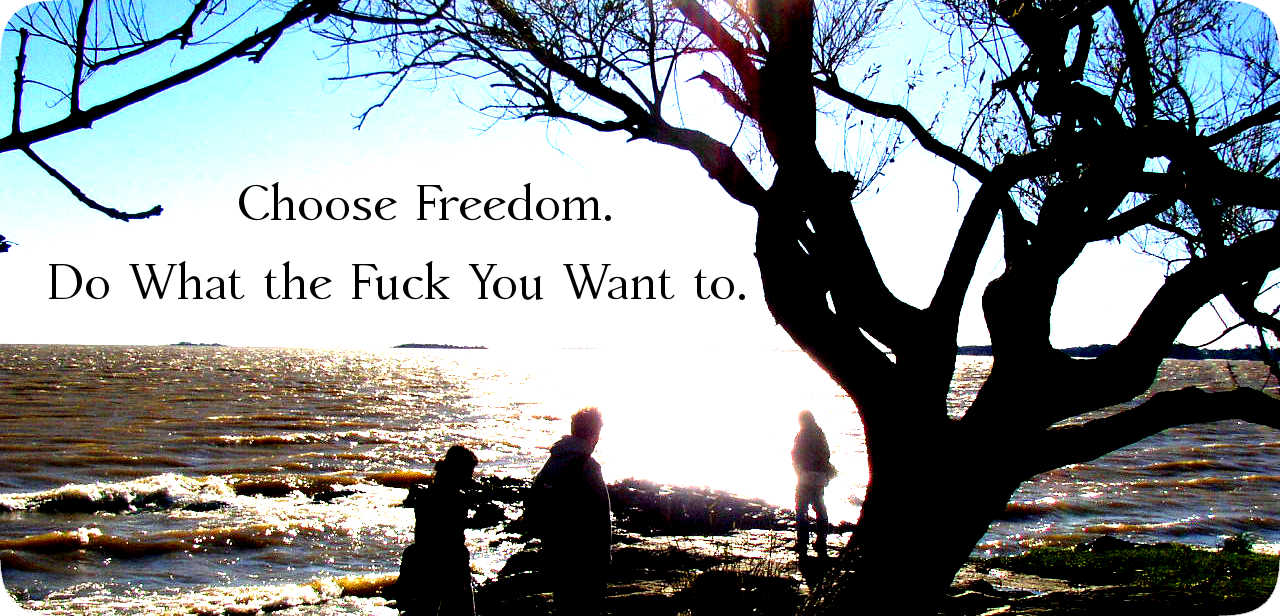
One style of software freedom, promoted by the WTFPL. But not the only style.
Why I washistorically a fan of permissive licenses
First, I wanted to maximize adoption anddistribution of my work, and releasing it under permissivelicenses facilitates that, by making it clear that there isnothing anyone needs to worry about if they want to build offof something I make. Enterprises are often unwilling to release theirprojects freely, and given that I did not see myself having any abilityto nudge them to fully join the free software side, I wanted to avoidbeing needlessly incompatible with the approach they already had andwould not give up.
Second, I generally philosophically dislikecopyright (and patents). I dislike the idea that two peopleprivately sharing bits of data between each other can be perceived ascommitting a crime against a third party whom they are not touching oreven communicating with and are not taking anything away from (no, "notpaying" is NOT the same as "stealing"). Explicitly releasing to publicdomain is legallycomplicated for various reasons, and so a permissive license is thecleanest and safest way to get as close as possible to not copyrightingyour works.
I do appreciate the copyleft idea of "using copyright againstitself" - it's a beautiful legal hack. In some ways it'ssimilar what I always found philosophically beautiful aboutlibertarianism. As a political philosophy, it's often described asbanishing the use of violent force except for one application: toprotect people from other violent force. As a social philosophy, Isometimes see it as a way of taming the harmful effects of the humandisgust reflex by making freedom itself a sacredthing that we find it disgusting to defile: even if you think two otherpeople having an unusual consensual sexual relationship is disgusting,you can't go after them, because interfering in the private lives offree human beings is itself disgusting. So in principle, there arehistorical precedents to show that disliking copyright is compatiblewith using copyright against itself.
However, while copyleft of written work fits into thisdefinition, GPL-style copyright of code overstepsbeyond a minimalistic notion of "using copyright against itself",because it offensively uses copyright for a different purpose: mandatingpublication of source code. This is a public-spirited purpose,and not a selfish purpose of collecting licensing fees, but it isnevertheless an offensive use of copyright. This becomes even more truefor stricter licenses like the AGPL, whichrequire publication of source code of derivative works even if you neverpublish them and only make them available via software-as-a-service.
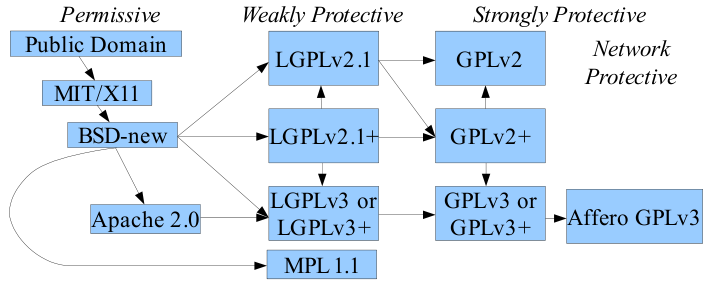
Different types of software licenses, with different setsof conditions under which someone making a derivative work is requiredto share the source code. Some of them require publishing source codeunder a wide variety of situations.
Why I am warmer to copylefttoday
My switch from favoring permissive to favoring copyleft is motivatedby two world events and one philosophical shift.
First, open source has become mainstream, and nudgingenterprises toward it is much more practical. Plenty ofcompanies in all kinds of industries are embracing open source.Companies like Google, Microsoft and Huawei are embracingopen source, and even building major software packages open. Newindustries, including AI and of course crypto, are heavier on opensource than previous industries ever were.
Second, the crypto space in particular has become morecompetitive and mercenary, and we are less able than before tocount on people open-sourcing their work purely out of niceness. Hence,the argument for open source cannot just rely on "please"; it must alsobe accompanied by the "hard power" of giving access to some code only tothose who open up theirs.
One way to visualize how both pressures increase the relative valueof copyleft is a graph like this:
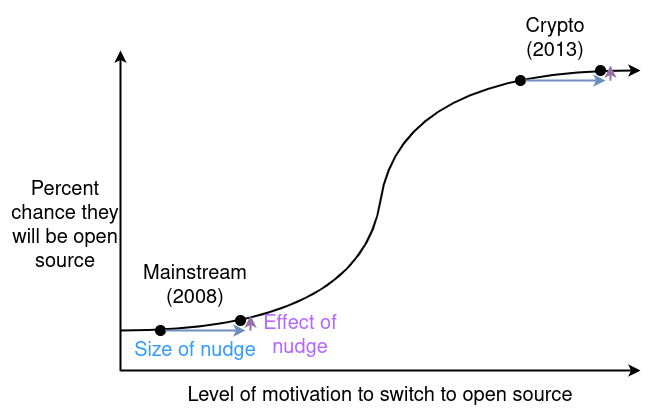
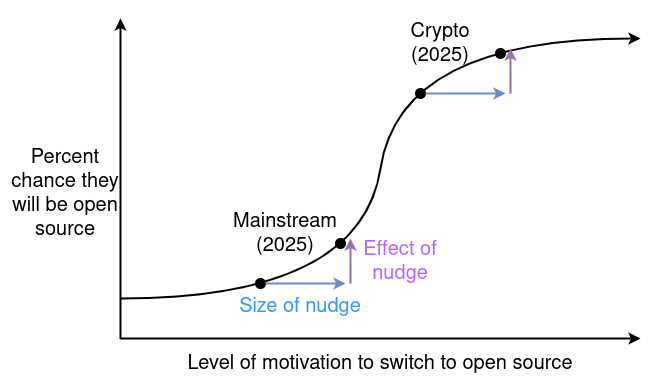
Incentivizing open source is most valuable in situationswhere it's neither unrealistic, nor guaranteed. Today, both mainstreamenterprise and crypto are in that situation. This makes the value ofincentivizing open source via copyleft high.
Third, Glen Weyl-style economic arguments haveconvinced me that, in the presence of superlinear returns to scale,the optimal policy is actually NOT Rothbard/Mises-style strict propertyrights. Rather, the optimal policy does involve some nonzero amount ofmore actively pushing projects to be more open than they otherwise wouldbe.
Fundamentally, if you assume economies of scale, then by simplemathematical reasoning, nonzero openness is the only way that the worlddoes not eventually converge to one actor controlling everything.Economies of scale means that if I have 2x the resources that you do, Iwill be able to make more than 2x the progress. Hence, next year, I willhave eg. 2.02x the resources that you do. Hence...
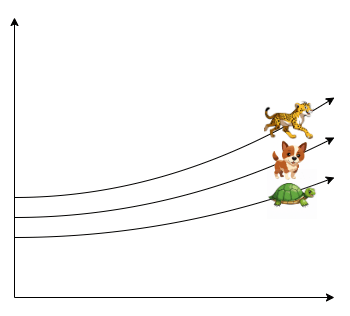
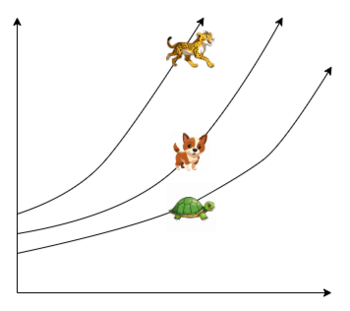
Left: proportional growth. Small differences at the startbecome small differences at the end. Right: growth with economies ofscale. Small differences at the start become very large differences overtime.
A key pressure that has prevented this dynamic from gettingout of hand historically is the fact that we are not able to opt out ofdiffusion of progress. People move between companies andbetween countries and take their ideas and talents with them. Poorercountries are able to trade with richer countries and get catch-upgrowth. Industrial espionage happens everywhere. Innovations getreverse-engineered.
More recently, however, several trends threaten this balance, and atthe same time threaten other factors that have kept unbalanced growth incheck:
- Rapid technological progress, which allowssuper-exponential curves to be much faster than before.
- Greater political instability both within andbetween countries. If you are confident that your rights will beprotected, then someone else getting stronger without touching you doesnot hurt you. But in a world where coercion is more feasible andunpredictable, someone becoming overly powerful compared to others ismore of a risk. At the same time, within countries, governments are lesswilling to restrain monopolies than before.
- The modern ability to make proprietary software and hardwareproducts that distribute ability to use without diffusing ability tomodify and control. Historically, giving a product to aconsumer (whether within a country or between countries) inevitablyimplied opening it up to inspection and reverse-engineering. Today, thisis no longer the case.
- Limitsto economies of scale, historically a key limiterof runaway growth, are weakening. Historically, larger entitieshave had disproportionately higher monitoring costs, and difficultysatisfying local needs. More recently, digital technology again makesmuch larger-scale structures of control and monitoring possible.
This all increases the possibility of persistent, and evenself-reinforcing and growing, power imbalances between companies andbetween countries.
For this reason, I am increasingly okay with stronger efforts to makediffusion of progress something that is more actively incentivized ormandatory.
Some recent policies made by governments can be interpreted as beingabout attempting to actively mandate higher levels of diffusion:
- EU standardization mandates (eg. mostrecently USB-C), which make it harder for build proprietaryecosystems that do not play nicely with other technology
- Forcedtechnology transfer rules in China
- USA banningnon-compete agreements, which I support on the grounds that theyforce the "tacit knowledge" inside of companies to be partially opensource, so once an employee leaves one company they can apply skillslearned there to benefit others. Non-disclosure agreements limit this,but are fortunately very porous in practice.
In my view, the downsides of policies like these tend to come fromtheir nature of being coercive policies of a government, which leads tothem preferentially incentivizing types of diffusion that are heavilytilted toward local political and business interests. But the upside ofpolicies like this is that they, well, incentivize higher levels ofdiffusion.
Copyleft creates a large pool of code (or other creative products)that you can only legally use if you are willing to share the sourcecode of anything you build on it. Hence, copyleft can be viewedas a very broad-based and neutral way of incentivizing more diffusion,getting the benefits of policies like the above without many of theirdownsides. This is because copyleft does not favor specificactors and does not create roles for active parameter setting by centralplanners.
These arguments are not absolute; in some cases, maximizing thechance that something gets adopted by truly everyone is worth licensingit permissively. However, on the whole, the benefits of copyleft aremuch greater today than they were 15 years ago, and projects that wouldhave gone permissive 15 years ago should at least think about adoptingcopyleft today.
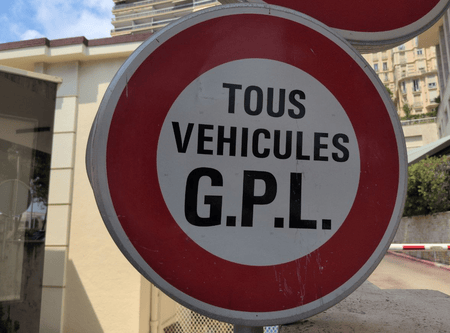
Today, this sign unfortunately means somethingtotally unrelated. But in the future, maybe we can have open-sourcecars. And perhaps copyleft hardware can help make that happen.
免责声明:本文章仅代表作者个人观点,不代表本平台的立场和观点。本文章仅供信息分享,不构成对任何人的任何投资建议。用户与作者之间的任何争议,与本平台无关。如网页中刊载的文章或图片涉及侵权,请提供相关的权利证明和身份证明发送邮件到support@aicoin.com,本平台相关工作人员将会进行核查。




